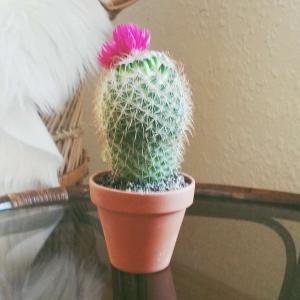植物经验
详细说明
Light: Mammillaria species appreciate strong light, but many species dislike more than four hours of direct summer sunlight. Provide bright, even light for the best results.
Water: Allow the soil mix to become nearly dry between waterings, but then water thoroughly. Immaculate drainage is essential, so never let the pots sit in water. Suspend watering in the winter, but mist occasionally.
Soil: A rich, fast-draining cactus mix is ideal.
Fertilizer: During the growing season, fertilizewith a cacti fertilizer mix. Suspend feeding during the dormant winter period.
Propagation:
Mammillaria cacti can be propagated easily from offsets, which readily form in clusters around the base of the mother plant. To propagate, carefully remove the offset and allow the cut to dry on a paper towel for a few days.
Depending on the size of the cut area, a callous will form over the cut surface. Once the callous has formed, place the new plant in a pot with a potting soil mixture and keep in a warm place until new roots emerge. Once the plant is established, repot it into a regular container.
Repotting:
Repot as needed, preferably during the warm season.
To repot a cacti, make sure the soil is dry before repotting, then gently remove the pot. Knock away the old soil from the roots, making sure to remove any rotted or dead roots in the process. Treat any cuts with a fungicide. Place the plant in its new pot and backfill with potting soil, spreading the roots out as you repot. Leave the plant dry for a week or so, then begin to water lightly to reduce the risk of root rot.
Varieties:
There are multitudes of Mammillaria in circulation, ranging from very easy to grow to very difficult and highly prized by collectors. By far the most popular (in fact, the most popular cactus by some measures) is the M. zeilmanniana, which has the unusual (for a cactus) trait of blooming several times throughout the summer with multiple rings of pink and white flowers around the crown. Another popular species is the M. spinosissima, which has been in cultivation for a long time and features a ring of red flowers. Both are very easy to grow.
Grower's Tips:
If you can grow cacti and succulents successfully, you can likely grow the popular Mammillaria without too much trouble. To encourage better flowering, allow the plants to enjoy a cooling period in the winter and suspend watering.
Unlike many other cacti, which use their ribs as storage devices, the Mammillaria feature raised tubercles, from which spines emerge. When you water, the tubercles will expand to allow for increased water storage. The flowers emerge from the axils of these tubercles on the previous year's growth, which accounts for their interesting halo effect. It's imperative that the cactus is not exposed to prolonged dampness and sitting water. Never let your cactus sit in a dish of water. Lastly, make sure to fertilizer during the growing season for the best results.
Water: Allow the soil mix to become nearly dry between waterings, but then water thoroughly. Immaculate drainage is essential, so never let the pots sit in water. Suspend watering in the winter, but mist occasionally.
Soil: A rich, fast-draining cactus mix is ideal.
Fertilizer: During the growing season, fertilizewith a cacti fertilizer mix. Suspend feeding during the dormant winter period.
Propagation:
Mammillaria cacti can be propagated easily from offsets, which readily form in clusters around the base of the mother plant. To propagate, carefully remove the offset and allow the cut to dry on a paper towel for a few days.
Depending on the size of the cut area, a callous will form over the cut surface. Once the callous has formed, place the new plant in a pot with a potting soil mixture and keep in a warm place until new roots emerge. Once the plant is established, repot it into a regular container.
Repotting:
Repot as needed, preferably during the warm season.
To repot a cacti, make sure the soil is dry before repotting, then gently remove the pot. Knock away the old soil from the roots, making sure to remove any rotted or dead roots in the process. Treat any cuts with a fungicide. Place the plant in its new pot and backfill with potting soil, spreading the roots out as you repot. Leave the plant dry for a week or so, then begin to water lightly to reduce the risk of root rot.
Varieties:
There are multitudes of Mammillaria in circulation, ranging from very easy to grow to very difficult and highly prized by collectors. By far the most popular (in fact, the most popular cactus by some measures) is the M. zeilmanniana, which has the unusual (for a cactus) trait of blooming several times throughout the summer with multiple rings of pink and white flowers around the crown. Another popular species is the M. spinosissima, which has been in cultivation for a long time and features a ring of red flowers. Both are very easy to grow.
Grower's Tips:
If you can grow cacti and succulents successfully, you can likely grow the popular Mammillaria without too much trouble. To encourage better flowering, allow the plants to enjoy a cooling period in the winter and suspend watering.
Unlike many other cacti, which use their ribs as storage devices, the Mammillaria feature raised tubercles, from which spines emerge. When you water, the tubercles will expand to allow for increased water storage. The flowers emerge from the axils of these tubercles on the previous year's growth, which accounts for their interesting halo effect. It's imperative that the cactus is not exposed to prolonged dampness and sitting water. Never let your cactus sit in a dish of water. Lastly, make sure to fertilizer during the growing season for the best results.
花相册 (1)

brielle
2017年09月04日

This is my first growing diary.







